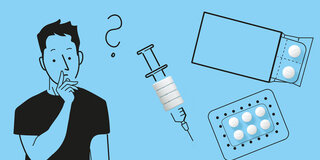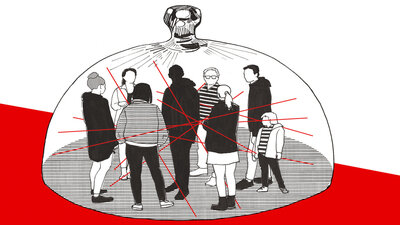The Boon and Bane of Painkillers

Medicine against the pain: Taken frequently and sometimes unwisely.
© W&B/Patrick Paulin/Dr. Ulrike Möhle
Letizia Marsili knows no pain. ‘We are impervious to it – for three generations’, she told the Italian daily press in December 2017. A team of researchers had just found out the reasons for the analgesia of the family: Marsili’s mother, her own two children, Marsili herself and another two relatives all have a certain alteration of their genome.
The cells usually responsible to transmit pain signals to the brain don’t do their job. ‘We lead a normal life, maybe an even better one than the rest of the population’, she said at the publication of the research relating to her family in the scientific journal Brain. Marsili was 52 years of age at the time of publication.
Not to know any pain! Almost everyone should know numerous situations in which he or she would have wished for that. After an injury, or when a certain body part makes itself known unpleasantly without any extraneous cause. And many people suffer from permanent or repeated pain – in the back, certain joints, or in the head. More than ten percent of the people in Germany suffer from chronic pain: by definition lasting at least for three months.
The history of painkillers
Humans have probably always used substances to alleviate their afflictions. The latex produced by poppy seed pods has been the first painkiller we know of. In the region of today’s Iraq, poppies were farmed well over 5,000 years ago to produce the painkilling liquid. In 1804, the German pharmacy assistant Friedrich Sertürner isolated a pure substance called morphine from the dried latex better known as opium. Morphine is still a very important drug in today’s modern pain management. We now have synthetic opioids with a hundred-fold or even thousand-fold impact – priding the same effect as morphine in a much lower dosage.
Opioids are one of a number of substance classes used to alleviate pain. The right drug relates – amongst other things – to the intensity of the affliction. Doctors use a scale from zero to ten to get an idea: zero means no pain at all, ten means unbearable agony.
‘This simple scale of numbers is very helpful, for example, after surgery’, says pain researcher Professor Herta Flor from the Central Institute of Mental Health (CIMH) at the Medical Faculty Mannheim. That way, doctors can control the effectiveness of the drugs used and adjust them if necessary. ‘It is important to keep patients pain-free, ideally, after surgery. That reduces the risk of chronified pain’, she explains.
Different sorts of painkillers
Pain therapy based on drugs is administered under a three-level WHO guideline. Against minor pain, substances like acetylsalicylic acid, ibuprofen, diclofenac or paracetamol are recommended. Against moderate to strong pain, weaker opioids are recommended, against extreme pain strong opioids. If necessary, certain additional substance are used.
The WHO formula, however, merely provides a broad orientation. Professor Winfried Häuser, a member of the Pharmaceutical Commission of the German Medical Association, considers the formula misleading when applied to pain not caused by cancer. According to Häuser, it dissembles the idea that strong opioids are always the most effective painkiller.
‘It depends on the particular illness and the origins of pain which painkiller is most suitable’, he opines. The guidelines of the medical Scientific Societies are better suited to help doctors take the appropriate decisions. ‘Patients can read up themselves. People with a pain in the back for example in the National Health Care Guidelines, presented in layperson’s terms’, Häuser adds.
Pain caused by osteoarthritis, for example, is usually best treated with so-called cyclooxygenase inhibitors (COI) like diclofenac and ibuprofen. In case of rheumatic afflictions, cortisone-based drugs help against acute inflammatory episodes. Other rheumatism-specific pharmaceuticals keep the inflammations at bay more long-term. Neuralgia can often be treated with the anti-epilepsy drug pregabalin and certain anti-depressives. For tumour pain, opioids often remain the drug of choice.
Other methods against pain
However, drugs are not the only means against pain. ‘In many cases, other methods are more effective in the long-term, and also more agreeable’, says Häuser. For chronic muscle pain – or fibromyalgia – anti-inflammatory drugs are often almost ineffective. Light endurance training combined with a psychotherapy are often more effective in the long-term than any drug. Movement and relief of strain is often the best medicine for arthritic joints. In case of chronic back pain, physiotherapy and rehab training can help. Doctors and health insurers will be of help to find the best options.
Painkillers are a boon, on the one hand: Thanks to them, almost nobody has to suffer unbearable agony today. But they can become a bane, too. The example of the USA illustrates the impact of the wrongful use of painkillers. According to the US Center for Disease Control and Prevention (CDC), about 932,000 people have died in the USA from an overdose of drugs or pharmaceuticals since 1999. Most of the victims initially became dependent on painkillers prescribed by their doctors. The phenomenon has become known as the ‘opioid crisis’.
The situation in Germany
In Germany, there is no such crisis. Some reasons for that: Germany has stricter rules regarding the prescription of opioids. And the German health system is better the America’s. Also, there is no such social decline of whole sections of the population over here. In the USA, that social decline is one of the reasons for the opioid crisis.
On the other hand, more opioids per head are prescribed in Germany compared to most other countries. ‘0.3 percent to five percent of the patients don’t use these pharmaceuticals appropriately’, Häuser says. Some take opioids without any obvious benefit, others get addicted to them. Reversely, the fear of an opioid dependency might be harmful if an opioid therapy is not undergone, although it is medically advisable.
Generally, patients ought to take painkillers the way they are prescribed. In case of side-effects, you should talk to your doctor or pharmacist. And every patient should know for how long painkillers should maximally be taken. Painkillers do not eliminate the cause of an ailment. On top of that, many drugs use their pain-limiting effectiveness as time goes by. Some opioids can even enhance the experience of pain. And some headache remedies even cause further headaches after a while.
‘With chronic pain, the patterns of nerve activity get altered’, Herta Flor explains. The pain has developed a momentum of its own, so to speak, and taken root in the mind. The good news: Chronic pain can be unlearned.
Painfree people don’t need all that. But are their lives truly better? Flor has her doubts: ‘I don’t wish it on anybody to have no pain at all. That can even be life-threatening.’ Studies have proven the disadvantages. Indolent people burn themselves on hot stove plates or break their bones without initially noticing. Especially small children are in danger. After teething, they can injure their tongue, lips, or fingers. But then, only very few people are truly indolent. Their genetic condition might, however, help researchers to develop new drugs that simulate their altered genome.
Painkillers: Their Benefits and Risks
What causes the pain? What type of pain? How sick is the patient? All of that has to be taken into account when deciding on an appropriate painkilling drug. Short profiles of the most important agony reliefs.
You fell on your knee or your head is in pain: Painkillers often give you some short-term relief. The degree of suffering is higher if you suffer from chronic pain. In that case, pain medication should only be used in combination with other measures like relaxation techniques, organised exercising or psychotherapy.
What is true in all cases: Painkillers should be used for as brief a period as possible and in the lowest effective dosage. Because they all have side-effects and may interact with other drugs. With some concomitant diseases, certain types of painkillers are out of the question. But if all risks are taken into account, painkillers can be a boon. Not all of them have to be swallowed, there are alternative ways to get them into the body, as the illustrations show.
What is important when taking painkillers: The underlying disease causing the pain must also be treated. For example with rheumatism medication or surgery to treat carpal tunnel syndrome. Sometimes, however, permanent medicamentous pain treatment is unavoidable. Nevertheless, especially cyclooxygenase inhibitors (COI) should not be taken on more than ten days per month. Otherwise, they can actually cause what they are supposed to prevent: headaches.
When in Pain, Consult Your Pharmacist
Interview: Dr Nadine Francke knows how important the pharmacy is for people suffering from pain.
What are the non-prescription painkillers you tend to recommend quite regularly, Dr Francke?
That varies a lot. Quite often, patients come into the pharmacy knowing already what they want. They ask for ibuprofen, paracetamol or acetylsalicylic acid (ACA), something against headaches. It is our job to give safe and good advice to our customers. In order to ascertain which drug we can recommend, we ask for the symptoms, whether the customer takes other medication or has other maladies. Some painkillers are out of the question, then. If you take anticoagulant drugs, for example, you should not combine them with so-called cyclooxygenase inhibitors (COI) like acetylsalicylic acid. There are many other risk factors we try to identify. If in doubt, we don’t sell any medication, but advise a visit to the doctor.
So, under which circumstances would you abstain from selling painkillers?
If I suspect that the patient has a medical problem that needs to be treated, I refer him or her to a doctor. The same goes for chronic diseases. In case of an emergency, like pain combined with signs of paralysis, we immediately call for medical attention.
For how long can you take a non-prescription painkiller?
There are clear guidelines. Over-the-counter painkillers may only be taken on ten days per month, and no longer than three days on the trot – maximally – without medical consultation. If you have a high need for painkillers, see your general practitioner.
How do you deal with chronic pain patients if the prescribed drug is not sufficient?
I try to find out, together with the patient, how I can help them. Sometimes, the prescribed medication does not take effect properly because it is not used appropriately. I ask the patient, for example, if they stick to the prescribed intervals, or if they apply the patch properly. If possible, I take the time to talk to customer in our consultation room. Sometimes, it is helpful to indicate alternative therapies, to point them towards a specialised consultant, a pain outpatient clinic, physio- or psychotherapists. We take an intermediary role.
Let’s Break the Vicious Cycle
If you want to treat pain successfully, you also have to unburden the soul.
‘So you think I am imagining the pain?’ When the mental influence upon pain is mentioned in pain therapy, many patients initially react defensively. They don’t feel taken seriously, or they think that they are being blamed for their agony. Professor Peter Henningsen certainly knows such reactions from his clinic. In order to explain how psyche and pain are related, he takes the patients into the vicious circle that they know so well.
‘Stress leads to tautness’, says the head of section for psychosomatic medicine and psychotherapy at the University Hospital ‘Rechts der Isar’ in Munich. If you are taut, the pain increases, he continues. Which leads to more stress, and in turn even more pain – a vicious circle. ‘That does not mean that stress is the cause of the pain’, Henningsen adds. It is simply the factor that gets the vicious circle going.
Modern pain therapy begins right here. It attempts to break the circle not just with medication, but also with other therapeutic methods. Experts nowadays work from a biopsychosocial model to explain the origins of pain. They consider psychological and social causes as much as biological – i.e. physical – ones. In most cases, these causes are intrinsically linked – even in our brain.
‘The networks dealing with physical pain and unpleasant emotions strongly overlap’, says Professor Heike Rittner. She is in charge of the Interdisciplinary Pain Centre at the University Hospital Würzburg. That brain connection can even be proven in role-play experiments: In one role-play, the unknowing test person is suddenly excluded from a game. We all know that exclusion is also painful. In our brain, similar areas to those dealing with physical pain get activated.
Psyche: Highly influential
But how much psyche is intrinsic in pain? There is no general answer to that question. ‘The effect possible via the psyche, however, is at least as effective as a painkiller’, says Professor Thomas Tölle, head of the Centre for Interdisciplinary Pain Medicine at the University Hospital ‘Rechts der Isar’ in Munich. Especially with chronic pain, the impact of the psyche is vital – even before they become chronified. It is not so much the condition of your spinal column that determines if back pain becomes a permanent: ‘The biggest risk factors are psychological and social’, Tölle explains.
At interdisciplinary pain centres, the therapy is divided into various parts, so-called modules. Experts from various medical disciplines co-operate closely. One vital building block, according to Heike Rittner: ‘During therapy, the patients learn to understand their disease.’ In case of knee, back or hip pain, you often find signs of attrition, so-called degenerative changes. Magnetic resonance imaging (MRI) can paint an impressive picture of these changes. Nevertheless, the patient may suffer as much from chronic pain as he or she can be almost pain-free. The physical damage does not necessarily lead to insufferable pain.
Diverting attention away from pain
The patients also find out how their agonies can be reduced by physical exercise or relaxation. Whether tai chi, yoga or group exercises: ‘It is all about the patient finding out what is good for him- or herself’, says Rittner. There are also exercises helping the patient to avert their attention away from the pain. To feel every part of their body – not just the ones afflicted by pain. ‘Many pain patients cannot focus on good things anymore. They re-learn that’, Thomas Tölle adds.
Every pain centre also employs experts from the field of psychotherapy. ‘To work psychotherapeutically, however, does not mean that a mental cause for the pain is assumed’, Peter Henningsen explains. One established method is behavioural therapy. Patients learn to change their behaviour and inner attitudes in a way to help them deal better with pain. In some cases, deep mental wounds cause the body to deal with pain in a bad way. ‘We know that childhood abuse or neglect lead to a biiger risk of pain problems in older age’, says Tölle.
Maybe the most important message the patients take with them: I am not at the mercy of my pain. I can do something against it. An experience many patients have pretty late, when the pain has already become chronified – and thus harder to treat.
Tölle advises patients to get the relevant information early on – from their general practitioner, for instance, who can refer them to a specialist. The German Pain Association recommends a new service that offers an interdisciplinary check-up after just six weeks of sustained pain. The plan is to offer that service in 24 centres. ‘Many could thus avoid chronic pain’, says Heike Rittner. In her clinic, the concept has already proved its value in a number of studies.












